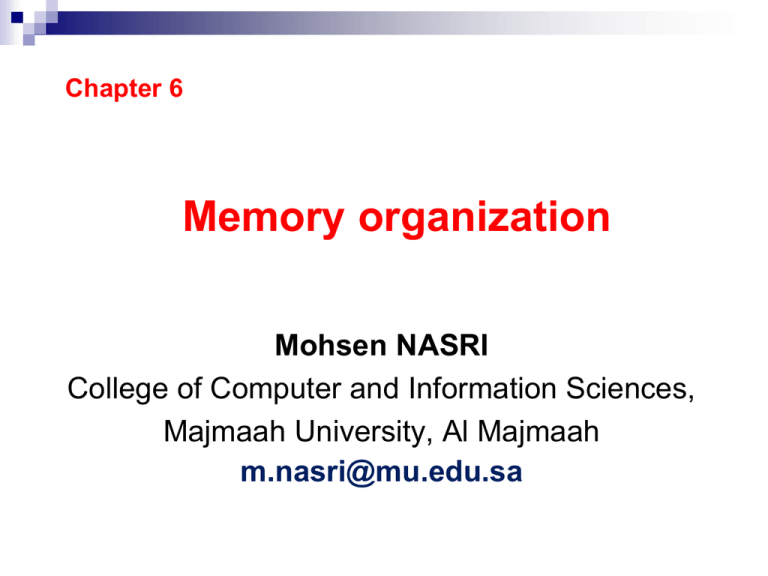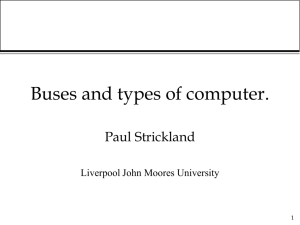Memory organization Mohsen NASRI College of Computer and Information Sciences,
advertisement

Chapter 6 Memory organization Mohsen NASRI College of Computer and Information Sciences, Majmaah University, Al Majmaah m.nasri@mu.edu.sa Memory Processor Memory Registers inside a microcomputer Store data and results temporarily No speed disparity Cost Primary or Main Memory Memory Store Programs and Data Storage area which can be directly accessed by microprocessor Store programs and data prior to execution Should not have speed disparity with processor Semi Conductor memories using CMOS technology ROM, EPROM, Static RAM, DRAM Erasable programmable read only memory Secondary Memory 2 Storage media comprising of slow devices such as magnetic tapes and disks Hold large data files and programs: Operating system, compilers, databases, permanent programs etc. Memory Basic concepts (Chip select) Read/Write m× n memory … Memory m words Data (m bits) … n bits per word Addresses ( n bits) 3 Memory Basic concepts The memory location with memory address 0000000000000000 holds the data 01111001. Memory Unit N : Number of data can be stored. C: Capacity/sized N = 2n C=mN The memory is divided into memory location Each location have a memory address By specifying its memory address, a memory location can be identified Memory How memory work? 000 Address Bus Address Decoder 0 1 0 how to write a word in the Address 010? 001 0 010 1 1 0 1 1 0 1 011 100 101 110 111 0 1 1 0 1 1 0 1 Data Bus 5 Memory How address decoder work? Memory 10 bit address Note: Address decoder 0 1023 Memory addresses are used in Hexadecimal 6 Memory Memory size Kilobyte Exact Number of bytes -----------------------210 Bytes Megabyte 220 bytes Gigabyte 230 bytes Terabyte 240 bytes Petabyte 250 bytes Exabyte 260 bytes Unit ------------ • 210 = 1,024 bytes ~ 1 thousand 220 = 1,048,576 bytes ~ 1 million 230 = 1,073,741,824 bytes ~ 1 billion Memory Access Time (read from/ write to memory) • 50 -75 nanoseconds (1 nsec. = 0.000000001 sec.) 7 Memory organization in 8086 8 Memory organization in 8086 Operation A0 Data Lines Used 1 Read/ Write byte at an even address 1 0 D7 – D0 2 Read/ Write byte at an odd address 0 1 D15 – D8 3 Read/ Write word at an even address 0 0 D15 – D0 4 Read/ Write word at an odd address 0 1 D15 – D8 in first operation byte from odd bank is transferred Read/ Write word at an even address 1 0 D7 – D0 in first operation byte from odd bank is transferred 9 Memory organization in 8086 Available memory space = EPROM + RAM Allot equal address space in odd and even bank for both EPROM and RAM Can be implemented in two IC’s (one for even and other for odd) or in multiple IC’s 10 Interfacing SRAM and EPROM Memory interface Read from and write in to a set of semiconductor memory IC chip EPROM Read operations RAM Read and Write In order to perform read/ write operations, Memory access time read / write time of the processor Chip Select (CS) signal has to be generated Control signals for read / write operations Allot address for each memory location 11 Interfacing SRAM and EPROM Typical Semiconductor IC Chip No of Address pins 20 12 Memory capacity Range of address in hexa 1 MB 00000 to FFFFF Interfacing SRAM and EPROM Memory map of 8086 EPROM’s are mapped at FFFFFH Facilitate automatic execution of monitor programs and creation of interrupt vector table 512 KB odd address space 512 KB even address space RAM are mapped at the beginning; 00000H is allotted to RAM 13 Interfacing I/O and peripheral devices I/O devices For communication between microprocessor and outside world Keyboards, CRT displays, Printers, Compact Discs Microprocessor etc. Ports / Buffer IC’s (interface circuitry) I/ O devices Data transfer types Memory mapped Programmed I/ O Data transfer is accomplished through an I/O port controlled by software 14 Interrupt driven I/ O I/O device interrupts the processor and initiate data transfer Direct memory access Data transfer is achieved by bypassing the microprocessor I/O mapped 8086 and 8088 comparison 8086 8088 16-bit Data bus lines obtained by demultiplexing AD0 – AD15 8-bit Data bus lines obtained by demultiplexing AD0 – AD7 20-bit address bus 8-bit address bus Two banks of memory each of 512 kB Single memory bank 6-bit instruction queue 4-bit instruction queue Clock speeds: 5 / 8 / 10 MHz 5 / 8 MHz No such signal required, since the data width is only 1-byte 15 Thank You Have a Nice Day






